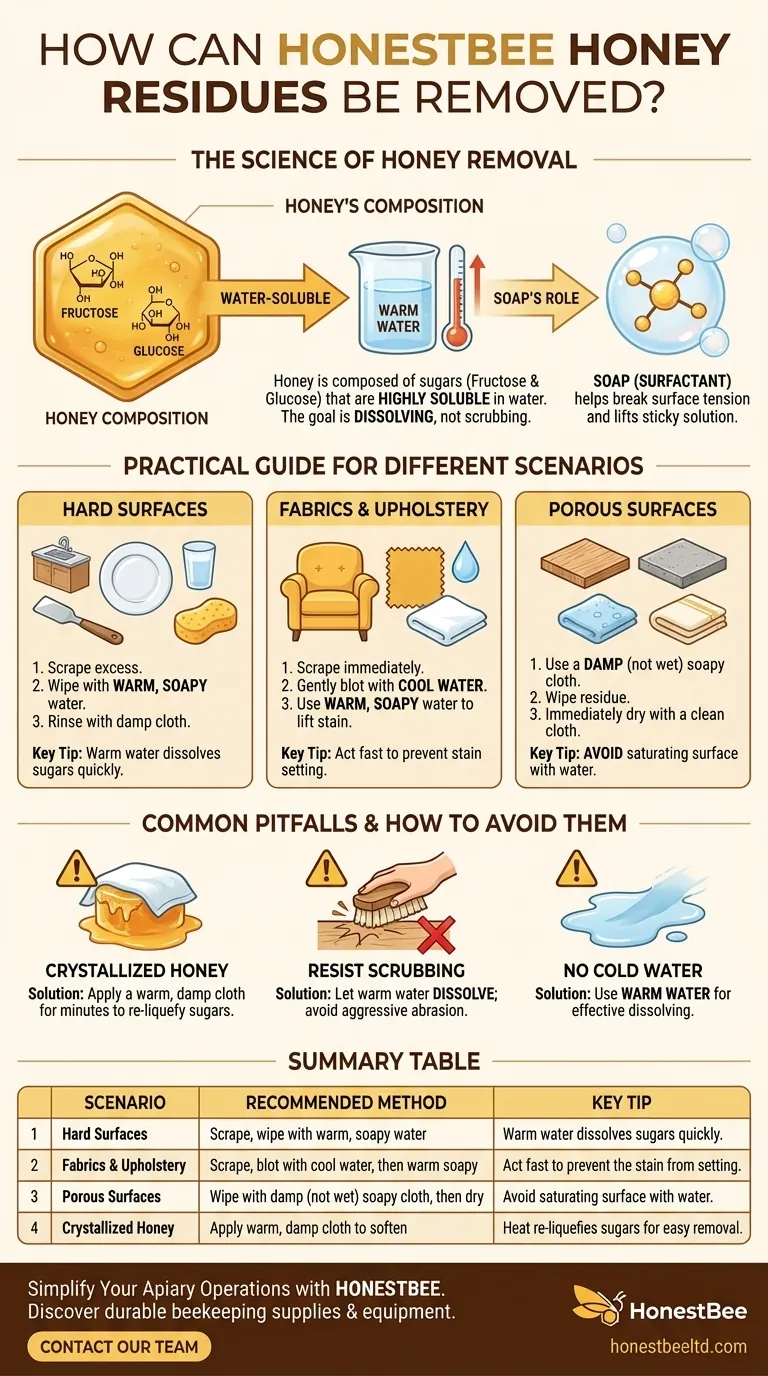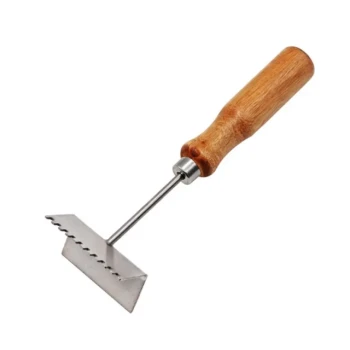Yes, removing honey residues is straightforward. The most effective method is a simple wash with warm water and soap. Because honey is composed almost entirely of sugars that are highly soluble in water, it does not require harsh chemicals or complex cleaning procedures.
The core principle to remember is that honey is water-soluble. Your primary tool for removing it is not brute force, but chemistry—using warm water to dissolve the sugars and a mild soap to lift them away from the surface.
The Science of Honey Removal
Honey's legendary stickiness can be intimidating, but understanding its composition is the key to defeating it. The cleaning process is about dissolving, not scrubbing.
Why Water is Your Best Ally
Honey is a supersaturated solution of two main sugars: fructose and glucose. Both of these sugars dissolve very easily in water. This is why a simple water-based cleaning approach is far more effective than trying to scrape away a dried spill.
The Critical Role of Temperature
Warm water works significantly faster and more effectively than cold water. The heat provides the energy needed to break down the sugar molecules more quickly, reducing the honey from a thick, viscous liquid to a thin, easily wipeable solution.
The Supporting Function of Soap
While warm water does the heavy lifting of dissolving the sugars, soap (a surfactant) plays a crucial supporting role. It helps break the surface tension of the water and lifts the sticky sugar solution away from the surface, ensuring a clean, non-sticky finish after rinsing.
A Practical Guide for Different Scenarios
The basic principle remains the same, but the technique should be adapted based on the surface you are cleaning.
For Hard, Non-Porous Surfaces
This applies to countertops, plates, glass, or sealed tiles. First, use a spoon or spatula to scrape off as much excess honey as possible. Then, simply wipe the area with a cloth or sponge soaked in warm, soapy water. Rinse with a clean, damp cloth to remove any soap residue.
For Fabrics and Upholstery
Time is of the essence here. Scrape off any excess honey immediately, being careful not to press it deeper into the fibers. Gently blot the stain with a clean cloth dampened with cool water first to prevent the stain from setting. Afterward, use a separate cloth with a small amount of warm, soapy water to blot the stain until it lifts.
For Porous Surfaces like Unsealed Wood
For materials like unsealed wood or stone, avoid saturating the area with water. Use a cloth that is damp with warm, soapy water, not soaking wet. Wipe the honey residue, then immediately follow with a clean, damp cloth to "rinse" and a dry cloth to absorb any excess moisture.
Common Pitfalls and How to Avoid Them
Even a simple process can have complications. Knowing the common mistakes will ensure a perfect result every time.
The Problem of Crystallized Honey
If you are dealing with crystallized honey, the solution is heat. Place a very warm, damp cloth directly on the hardened honey for a few minutes. This will gently warm and re-liquefy the sugars, allowing you to wipe them away easily with your soapy cloth.
Resisting the Urge to Scrub
Aggressive scrubbing is counterproductive. It can damage the surface you are trying to clean and is less effective than simply letting the warm water do its job. The goal is to dissolve the honey, not to physically abrade it off the surface.
Using Only Cold Water
Using cold water is a common mistake that will only smear the honey around, creating a larger sticky mess. The lack of heat energy means the sugars will not dissolve effectively, leading to frustration and more cleanup work.
Making the Right Choice for Your Situation
Your approach should be dictated by the type of spill you are facing.
- If your primary focus is a fresh spill on a hard surface: Scrape the excess immediately and use a warm, soapy cloth for a quick, effortless cleanup.
- If your primary focus is a spill on fabric or carpet: Act fast by scraping, blotting with a cool, damp cloth, and then gently cleaning with a minimal amount of warm, soapy water.
- If your primary focus is old or crystallized honey: Apply a very warm, damp cloth to the area for a few minutes to dissolve the sugars before wiping it away.
By understanding that honey's stickiness is easily defeated by warm water, you can handle any spill with confidence.
Summary Table:
| Scenario | Recommended Method | Key Tip |
|---|---|---|
| Hard Surfaces (Countertops, Glass) | Scrape excess, wipe with warm, soapy water. | Warm water dissolves sugars quickly. |
| Fabrics & Upholstery | Scrape, blot with cool water, then use warm, soapy water. | Act fast to prevent the stain from setting. |
| Porous Surfaces (Unsealed Wood) | Wipe with a damp (not wet) soapy cloth, then dry immediately. | Avoid saturating the surface with water. |
| Crystallized Honey | Apply a warm, damp cloth to soften before wiping. | Heat re-liquefies the sugars for easy removal. |
Simplify Your Apiary Operations with HONESTBEE
Cleaning honey residues is just one small part of efficient beekeeping. For commercial apiaries and distributors, having the right, high-quality equipment is essential for productivity and honey yield. HONESTBEE supplies durable, reliable beekeeping supplies and equipment through our wholesale-focused operations, helping you manage your business more effectively.
Ready to upgrade your operation's efficiency? Contact our team today to discuss your needs and discover how our products can support your success.
Visual Guide

Related Products
- High Quality Honey Dehumidifier Dryer Thickening Machine for Beekeeping
- Electric Honey Press Machine for Squeezing Honey Comb Press Equipment
- Plastic Honey Gate Spout with Wing Nut for Beekeeping Honey Bucket
- Professional Long-Handled Silicone Honey Scraper for Beekeeping
- Honey Concentrating Vacuum Heating Thickening Machine Dehumidifier for Honey
People Also Ask
- How to reduce moisture level in honey? Preserve Quality and Prevent Fermentation
- What are the advantages of a condensation honey dryer? Boost Quality & Yield for Your Apiary
- How does a honey dryer remove moisture from honey? Achieve Perfect Honey Stability with Controlled Drying
- How do you remove moisture from honey? Ensure Quality & Shelf-Stable Honey
- How does temperature regulation help in managing honey moisture content? Prevent Fermentation & Ensure Quality



















